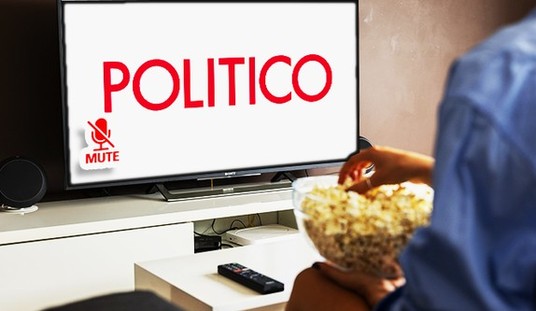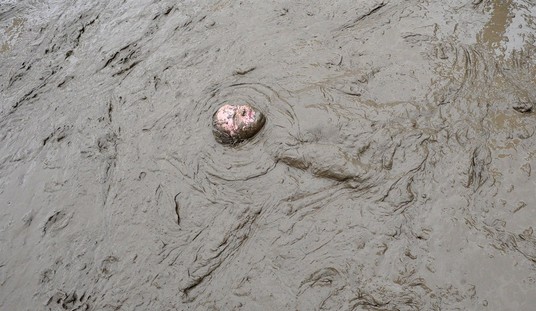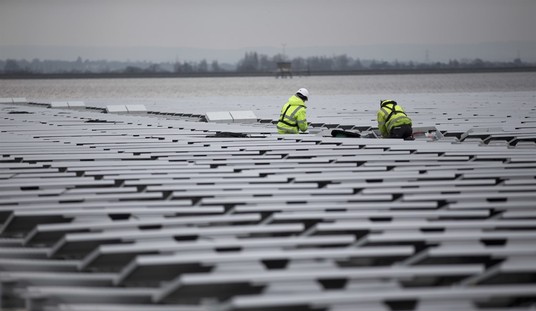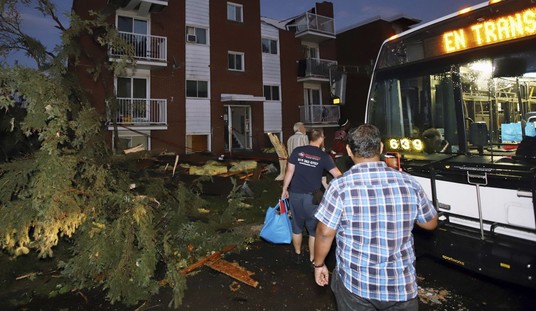
One of the wearying things about arguing with liberal/progressives is that they never stop trying to rewrite history; a bogus claim that is debunked only stays debunked if you keep at debunking it year after year after year. So it is with the hardy perennial effort to tar the reputation of Ronald Reagan by claiming that his 1980 presidential campaign and subsequent two-term presidency was tainted from the outset by having kicked off his campaign with a speech about “states’ rights” in Philadelphia, Mississippi – Nation editor Katrina Vanden Heuvel was retailing this one on ABC’s Sunday show The Week just two weeks ago, trying to compare Reagan to Donald Trump:
There’s all this nostalgia about Ronald Reagan. Ronald Reagan announced his candidacy in Philadelphia, Mississippi, the site for where three civil rights workers were killed by white supremacists.
There are many other sources that assert this as fact – see, for example, this Huffington Post column from April by Nicolaus Mills, Professor of American Studies, Sarah Lawrence College:
[I]n going to Patchogue, Long Island this coming Thursday to speak at a controversial Republican fundraiser, Trump is taking a page out of the Ronald Reagan playbook. He’s following the path that Reagan took in 1980 when he began his presidential campaign at the Neshoba County Fair in Philadelphia, Mississippi.
Long Island? Forget it, he’s rolling. More examples from one presidential cycle to the next can be found from David Greenberg at Slate, William Raspberry in the Washington Post, Paul Krugman and Bob Herbert in the New York Times, and so on. Wikipedia even has a page for “Reagan’s Neshoba County Fair “states’ rights” speech”.
Where to begin? This particular canard has so many things wrong with it, I feel obligated to set them all down in sequence. Hopefully, doing so here should – at least for a little while – collect the context in one place.
1. Reagan did not kick off his 1980 campaign in Mississippi. Unlike today, candidates in Reagan’s time tended to jump into the presidential race with a formal announcement of their candidacy. Reagan, befitting his skill with television, made his formal announcement with a tape recorded 24-minute speech from a study in New York City on November 13, 1979:
The speech touched on a number of Reagan’s campaign themes, ranging from taxes to gas lines to spiritual revival to calls for an early form of NAFTA, and included a passage that would become a regular Reagan staple, discussing the excesses of federal bureaucracy and the need to send more power back to the states:
We must put an end to the arrogance of a federal establishment which accepts no blame for our condition, cannot be relied upon to give us a fair estimate of our situation and utterly refuses to live within its means. I will not accept the supposed “wisdom” which has it that the federal bureaucracy has become so powerful that it can no longer be changed or controlled by any administration. As President I would use every power at my command to make the federal establishment respond to the will and the collective wishes of the people.
We must force the entire federal bureaucracy to live in the real world of reduced spending, streamlined functions and accountability to the people it serves. We must review the functions of the federal government to determine which of those are the proper province of levels of government closer to the people.
The 10th article of the Bill of Rights is explicit in pointing out that the federal government should do only those things specifically called for in the Constitution. All others shall remain with the states or the people. We haven’t been observing that 10th article of late. The federal government has taken on functions it was never intended to perform and which it does not perform well. There should be a planned, orderly transfer of such functions to states and communities and a transfer with them of the sources of taxation to pay for them.
The savings in administrative would be considerable and certainly there would be increased efficiency and less bureaucracy.
Reagan’s speech at the Neshoba County Fair in Mississippi would not come for another nine months, long into the campaign and well after Reagan had secured the GOP nomination.
2. The speech was not in Philadelphia. Contrary to the mythology that liberals have built around the speech, it was not “the site for where three civil rights workers were killed by white supremacists” in 1964, but at a county fair some 7 miles away. The Neshoba County Fair was not some kind of crypto-Klan event commemorating the murders; in 1980 it was celebrating its 89th year, drew tens of thousands of people annually, and was a sufficiently large popular event that it was profiled in a National Geographic article in June 1980, which is where Reagan’s staff got the idea to have him speak there:
Team Reagan found this particular event attractive after reading a June 1980 National Geographic magazine article titled “Mississippi’s Grand Reunion at the Neshoba County Fair.”
It seems unlikely that the National Geographic article was part of some sort of conspiracy to deliver racially coded messages through the Reagan campaign. The more logical conclusion is that Reagan’s campaign saw an opportunity to reach an enormous crowd (accounts of the event said that Reagan spoke to between 20-30,000 people) in a hotly contested swing state as he moved from the GOP Convention into the fall campaign.

3. Mississippi was a battleground state in 1980. It’s easy to forget in today’s era of red/blue maps – in which Mississippi is one of the reddest spots on the map – but the state was a potentially key battleground in 1980. A reliable “Solid South” state from 1876-1944 after Reconstruction ended and the Klan conducted, essentially, a terrorist campaign to suppress the Republican Party in the state, it had swung wildly with the racial politics of 1948-72, voting overwhelmingly for the Dixiecrat campaigns of Thurmond in 1948 and Wallace in 1968, the Republican campaigns of Goldwater in 1964 and Nixon in 1972, and solidly for the Democratic campaigns of Adlai Stevenson in 1952 and 1956, and breaking in a 3-way race for an uncommitted slate of electors against JFK and Nixon in 1960. But Jimmy Carter, a Georgian, had narrowly brought Mississippi back to the Democratic fold in 1976, beating Ford 49.6% to 47.7%; the state was decided by just 14,000 votes, providing 7 of Carter’s 57 electoral vote margin of victory (Ford would have been re-elected with just 25,000 more votes in Mississippi and Ohio).
The state was still heavily Democratic in 1980: Thad Cochran was elected to the Senate in 1978 as the first Republican to win a statewide election in Mississippi since Reconstruction; the Governor’s mansion would not be occupied by a Republican until 1992; and entrenched Dixiecrat Senator John Stennis would fend off a challenge from a young Republican named Haley Barbour in 1982.
And Mississippi had proven a tough state for Reagan personally to crack: in 1976, while Reagan swept every Southern state’s primary except Florida (which voted before Reagan’s first victory, in North Carolina), Mississippi held no popular vote and its delegation went for Ford at the convention, put off in part by Reagan’s selection of moderate Richard Schweiker. The loss of Mississippi sealed Reagan’s fate at the 1976 convention – but its preference for Ford is consistent with the pro-party-establishment tilt of the state GOP in every presidential season before 2016. Reagan claimed the state uncontested in the 1980 primaries, when it voted after George H.W. Bush had dropped out. It would go on to be a close race that fall, with Reagan beating Carter 49.4 to 48.1, winning the state by a little under 12,000 votes (i.e., around half the size of the crowd Reagan spoke to that day). Although the 1980 election was a 44-state landslide, Mississippi was one of eight states decided by less than 2 points, seven of which went to Reagan – the only closer states were Massachusetts, Tennessee, Arkansas, and Alabama, and it was one of just five states (plus D.C.) where Carter cleared 48% of the vote (the others being Georgia, Hawaii, West Virginia, Tennessee, and South Carolina).
Meanwhile, President Carter opened his general election campaign in Tuscumbia, Alabama, then the national headquarters of the Ku Klux Klan (there was a Klan rally the day Carter came to Tuscumbia). Reagan actually got in a lot of trouble for blasting Carter for that choice of location, inaccurately describing Tuscumbia as the location of the Klan’s founding, prompting Carter to accuse Reagan of stereotyping white Southerners and the Democratic Governor of Mississippi to predict that Reagan would lose votes in the state because “voters thought it showed a lack of understanding about the South.”
In other words, especially with polling being a much less precise art than it is today, it would have been very unusual for Reagan not to visit Mississippi in the fall campaign in 1980. It was a major potential swing state, and the Neshoba County Fair was the year’s best opportunity to meet a large crowd. That’s why it was a common stop for Mississippi politicians, and why Michael Dukakis went there in 1988; Dukakis managed to mention at his appearance that the Fair was near the birthplace of Oil Can Boyd, but not mention the slain civil rights workers. Liberals who argue today that Reagan should have simply ceded a swing state that Carter was vigorously chasing cannot be serious.

4. Reagan deliberately balanced the one-day Neshoba appearance with a week-long pitch to urban black voters in the North. Much of the “symbolism” invoked by critics of the Neshoba speech is focused on the fact that this was Reagan’s first appearance of the general election campaign. As noted above, that’s rather artificial: Reagan had been running officially since November and unofficially since 1975, and he formally locked up the nomination when Bush dropped out at the end of May. And while Neshoba was his first stop on the trail after the GOP Convention in Detroit two weeks earlier, the decision to put it first was actually a deliberate choice to not look like Reagan was pandering to racists, because it was immediately followed by a full week dedicated to making a (futile, in retrospect) pitch to black voters:
Reagan strategists decided to spend the week following the 1980 Republican convention courting African-American votes. Reagan delivered a major address at the Urban League, visited Vernon Jordan in the hospital where he was recovering from gunshot wounds, toured the South Bronx and traveled to Chicago to meet with the editorial boards of Ebony and Jet magazines.
Lou Cannon of The Washington Post reported at the time that this schedule reflected a shift in Republican strategy….Reagan’s pollster Richard Wirthlin urged him not to go, but Reagan angrily countered that once the commitment had been made, he couldn’t back out.
The Reaganites then had an internal debate over whether to do the Urban League speech and then go to the fair, or to do the fair first. They decided to do the fair first, believing it would send the wrong message to go straight from the Urban League to Philadelphia, Miss.
Cannon’s report at the time quoted a campaign source making explicit that the order of the appearances was staged so the Neshoba appearance wouldn’t send the wrong message:
Republican presidential nominee Ronald Reagan today used rural Mississippi to launch a three-day swing that reflects the diversity and the difficulties of his approach to the campaign.
Reagan spoke here to a conservative rural audience assembled at the Neshoba County Fair. Then he flew to New York where he is scheduled to make what his aides call “a major, substantive speech” to the National Urban League on Tuesday….
“It would have been like we were coming to Mississippi and winking at the folks here, saying we didn’t really mean to be talking to them Urban League folk,” said one Reagan source. “It would have been the wrong signal.”

Reagan’s Urban League message was not exactly the stuff of George Wallace:
“I am committed to the protection of the civil rights of black Americans,” Reagan told the Urban League. “That commitment is interwoven into every phase of the programs I will propose.”
The Christian Science Monitor noted of the Urban League appearance and its stress on the economy that “Mr. Reagan also seeks to bring back into the Republican Party the black voters who followed Franklin D. Roosevelt into the New Deal in another economic crisis.”
A little over a decade removed from the end of the political movement to defend segregation, and in an era when forced busing to integrate schools was still a hot-button issue, it’s not at all remarkable that Reagan (or any candidate) would want to present himself as a candidate who could appeal both to white Wallace voters and to black voters in the North. It’s silly to look at the careful effort to send that message, with much more of the candidate’s time devoted to the latter, and charge Reagan with running a coded segregationist campaign.
5. “States’ rights” was not even an applause line in the speech. Aside from arguing with the location and timing of Reagan’s speech, critics have lambasted him for using the phrase “states’ rights” in the speech, to the point where it is often portrayed as the centerpiece of the speech. As noted above, devolving power from the federal government to the states was a regular theme of Reagan’s, and had been addressed in his announcement speech and many addresses since then. And as Reagan biographer Steven Hayward has observed:
[A]s a westerner Reagan had fully associated himself with the “Sagebrush Rebellion,” for whom “states’ rights” had no racial content, but rather meant wresting control of land from Washington. This was far from an outlandish or minority view. The same day Reagan made his “states’ rights” remark in Mississippi, the National Governors Association issued what the Associated Press described as “a militant call for reduced federal involvement in state and local affairs.” Arizona’s liberal Democratic Governor Bruce Babbitt wrote in a New York Times op-ed article that “It is time to take hard look at ‘states’ rights’ — and responsibilities — and to sort out the respective functions of the federal government and the states.”
But the speech was hardly focused on the issue. Reagan spoke for 15 minutes. You can listen to the whole speech yourself on YouTube, and read it here.
The full context is online from an amateur recording and available here, with Reagan’s remarks beginning at the 18 minute mark.
The introductions included Dick Molpus, a representative from the state’s Democratic governor, William Winter (in fact, Molpus was Winter’s Executive Director of the Governor’s Office of Federal-State Programs, in charge of overseeing the state’s vast and dysfunctional dependence on Washington aid), who noted Reagan’s presence as the first presidential nominee to speak at the fair, and used that to echo Winter’s statement in his inauguration that January that Mississippi “is now entering the mainstream of American life.” Gov. Winter was a racial moderate, in the parlance of the Southern politics of the day, which meant – like Carter – a Democrat who supported segregation when it was popular but was trying to move beyond it in the 1970s. He supported Carter, not Reagan, and told the Washington Post the following month that “we’re seeing a determination, in the South, to stay with a man who understands our own special problems.” But his spokesman’s choice of words is also telling: white Mississippians in that era felt acutely their isolation from an American mainstream that had (rightly) spent most of the previous two decades scorning the state’s oppressive racial policies and attitudes. Reagan’s presence in Neshoba, like Carter’s presence in the White House, was seen as a valued sign of legitimacy.
Another of the introductions, which included several gifts, stressed that Philadelphia was the headquarters of the Choctaw Nation in Mississippi.
Reagan acknowledged that he was deep in long-held Democratic territory:
I know that in speaking to this crowd, that I’m speaking to what has to be about 90 percent Democrat. [A loud chorus of “No” from the crowd.] I just meant by party affiliation. I didn’t mean how you feel now. I was a Democrat most of my life myself, but then decided that there were things that needed to be changed.
About halfway into the speech, Reagan rolled into his discussion of federalism and welfare:
[Y]ou’ll never know how rewarding this is, this institution that has existed for so long-and as I said in the beginning, I know there is nothing-I have read all about it in the National Geographic. [Laughs] But, how did you ever accomplish this without a federal program? [Applause]
Sure, it’s right that we should say we want, too, to do something about unemployment, and about inflation, about the value of our money and to get this country moving again. But I think even more important on a broader scale – in doing that, what we’ll really do and what we will have to do is to bring back to this country what is so evident here: Bring back the recognition that the people of this country can solve the problems, that we don’t have anything to be afraid of as long as we have the people of America.
Over more recent years with the best intention, they have created a vast bureaucracy, or a bureaucratic structure-bureaus and departments and agencies-to try and solve all the problems and eliminate all the things of human misery that they can. They have forgotten that when you create a government bureaucracy, no matter how well intentioned it is, almost instantly its primary priority becomes preservation of the bureaucracy. [Applause]
Today, and I know from our own experience in California when we reformed welfare, I know that one of the great tragedies of welfare in America today, and I don’t believe stereotype after what we did, of people in need who are there simply because they prefer to be there. We found the overwhelming majority would like nothing better than to be out, with jobs for the future, and out here in the society with the rest of us. The trouble is, again, that bureaucracy has them so economically trapped that there’s no way they can get away. And they’re trapped because that bureaucracy needs them as a clientele to preserve the jobs of the bureaucrats themselves. [Applause]
I believe that there are programs like that, programs like education and others, that should be turned back to the states and the local communities with the tax sources to fund them, and let the people close to home [Applause drowns out the end].
I believe in state’s rights; I believe in people doing – people doing as much as they can for themselves at the community level and at the private level. And I believe that we’ve distorted the balance of our government today by giving powers that were never intended in the constitution to that federal establishment. And if I do get the job I’m looking for [pause for lots of applause], I’m going to devote myself to trying to reorder those priorities and to restore to the states and local communities those functions which properly belong there. [Applause]
I’m going to try – I’m going to try also to change federal regulations in the tax structure that has made this once powerful industrial giant in this land and in the world now with a lower rate of productivity than any of the other industrial nations, with a lower rate of savings and investment on the part of our people and put us back where we belong.
If you listen to the recording, you can clearly hear that there was a lot of applause at multiple points in this section, but nearly no audible reaction to the reference to “states’ rights” or even at the end of that or the following sentence. Nothing in this passage, or anywhere else in the speech, hits anything like a note of racial divisiveness – indeed, this very section of the speech is built around Reagan’s defense of the work ethic of welfare recipients, an issue usually portrayed by liberals as a coded racial appeal.
Some critics have argued (see here and here) over whether Reagan had previously used the term “states’ rights” in a speech, but this is grasping at straws given how the speech is customarily presented by liberal-progressives as some kind of racist smoking gun.
Listening to the speech itself, the context is impossible to misunderstand, and the reaction of the crowd tells the tale. The people of Neshoba liked what they heard from candidate Reagan, but the passing use of the phrase “states’ rights” was clearly not what their minds were on.













Join the conversation as a VIP Member